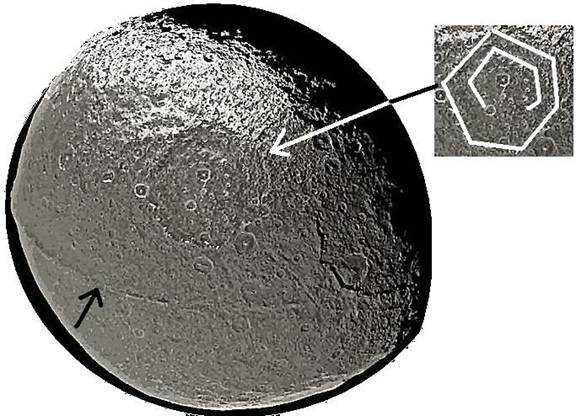by neufer » Wed Dec 09, 2009 2:16 pm
Horombo wrote:in looking at the amazing image of Tethys something unusual jumps out in the center of the moon. It is an almost perfectly symmetrical “tombstone-shaped” pentagon right on the moon’s equator and just to the right of Ithaca Chasma. Is this an artifact of imaging or something more? Nature doesn’t produce that many straight lines, especially those that connect, and certainly not on this scale. Does anyone else see this? Ideas?
http://aas.org/archives/BAAS/v37n3/dps2005/209.htm wrote:
The origin of polygonal impact craters - Evidence from Argyre region, Mars.
T. Ohman (Department of Geosciences, Division of Geology, University of Oulu, Finland), M. Aittola, V.-P. Kostama, M. Hyvarinen, J. Raitala (Department of Physical Sciences, Division of Astronomy, Uiversity of Oulu, Finland)
<<Polygonal impact craters are a ubiquitous feature on the surfaces of various bodies throughout the Solar System (Ohman et al., 2005). The currently favoured acoustic fluidisation model of impact crater's modification (collapse) stage requires that the rim material is nearly strengthless during the collapse, and thus can not have a ``memory" of the pre-existing crustal structures.
In the view of polygonal crater data, this is not the case. Therefore, at least a slight adjustment is required to the current cratering models for them to correctly depict nature.>>
http://www.rense.com/general80/moons.htm wrote:
 Iapetus, third largest moon of Saturn, has a massive hexagon shape, and the infamous ridge
Iapetus, third largest moon of Saturn, has a massive hexagon shape, and the infamous ridge (JPL)
 In this notated image of Phobos, we can see some of the hexagonal shapes on the moon's surface.
In this notated image of Phobos, we can see some of the hexagonal shapes on the moon's surface.
http://www.springerlink.com/content/1210617557g68261/ wrote:
The Characteristics of Polygonal Impact Craters on Venus
Marko Aittola1 Contact Information, Teemu Öhman1, 2, Johannes J. Leitner3 and Jouko Raitala1
<<Polygonal impact craters (PICs) are craters whose shape in plan view is more or less angular instead of being circular or ellipsoidal. This type of craters are present and often common on the Moon, Mercury, Mars and several asteroids and icy moons. This survey proves that there are polygonal impact craters on Venus and they may provide a good tool to analyse the properties of the planet’s surface/crust/lithosphere as well as the impact process itself. This study also collaborates our previous results, that PICs are not an anomaly among craters, but an integral part of all impact craters regardless of their size or environment.
Our study shows that there are regions where the straight segments of the crater rims most clearly follow the orientations of the dominant tectonic features of the area. Thus, the orientations of crater walls reflect–at least in some places–the local tectonics and zones of weakness also on Venus and could thus tell us about the directions and distributions of fractures or other zones of weakness in the crust.>>
[quote="Horombo"]in looking at the amazing image of Tethys something unusual jumps out in the center of the moon. It is an almost perfectly symmetrical “tombstone-shaped” pentagon right on the moon’s equator and just to the right of Ithaca Chasma. Is this an artifact of imaging or something more? Nature doesn’t produce that many straight lines, especially those that connect, and certainly not on this scale. Does anyone else see this? Ideas?[/quote]
[quote=" http://aas.org/archives/BAAS/v37n3/dps2005/209.htm"]
The origin of polygonal impact craters - Evidence from Argyre region, Mars.
T. Ohman (Department of Geosciences, Division of Geology, University of Oulu, Finland), M. Aittola, V.-P. Kostama, M. Hyvarinen, J. Raitala (Department of Physical Sciences, Division of Astronomy, Uiversity of Oulu, Finland)
<<Polygonal impact craters are a ubiquitous feature on the surfaces of various bodies throughout the Solar System (Ohman et al., 2005). The currently favoured acoustic fluidisation model of impact crater's modification (collapse) stage requires that the rim material is nearly strengthless during the collapse, and thus can not have a ``memory" of the pre-existing crustal structures. [b]In the view of polygonal crater data, this is not the case. [/b]Therefore, at least a slight adjustment is required to the current cratering models for them to correctly depict nature.>>[/quote]
[quote=" http://www.rense.com/general80/moons.htm"]
[img]http://www.rense.com/general80/fe004.jpg[/img]
[b]Iapetus, third largest moon of Saturn, has a massive hexagon shape, and the infamous ridge[/b] (JPL)
[img]http://www.rense.com/general80/42ge006.jpg[/img]
[b]In this notated image of Phobos, we can see some of the hexagonal shapes on the moon's surface.[/b][/quote]
[quote=" http://www.springerlink.com/content/1210617557g68261/"]
The Characteristics of Polygonal Impact Craters on Venus
Marko Aittola1 Contact Information, Teemu Öhman1, 2, Johannes J. Leitner3 and Jouko Raitala1
<<Polygonal impact craters (PICs) are craters whose shape in plan view is more or less angular instead of being circular or ellipsoidal. This type of craters are present and often common on the Moon, Mercury, Mars and several asteroids and icy moons. This survey proves that there are polygonal impact craters on Venus and they may provide a good tool to analyse the properties of the planet’s surface/crust/lithosphere as well as the impact process itself. This study also collaborates our previous results, that PICs are not an anomaly among craters, but an integral part of all impact craters regardless of their size or environment. [b]Our study shows that there are regions where the straight segments of the crater rims most clearly follow the orientations of the dominant tectonic features of the area.[/b] Thus, the orientations of crater walls reflect–at least in some places–the local tectonics and zones of weakness also on Venus and could thus tell us about the directions and distributions of fractures or other zones of weakness in the crust.>>[/quote]